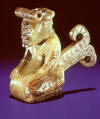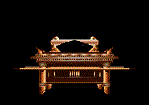|
from UfoEvidence Website
It is sometimes said to have
been destroyed in earthquakes generated by a pole shift which
occurred some 26,000 years ago, or at approximately 24,000 B.C.
This training period lasted
for seven years; so the earliest age at which a person could become
a citizen of the empire was 28.
The relatively small islands which had existed in the Atlantic during the time of the Lemurian civilization were left high and dry by the receding ocean. The newly emerged land joined the Poseid Archipelago of the Atlantic Ocean to form a small continent.
This continent is called
Atlantis by historians
today, though
its real name was Poseid.
In the book A Dweller On Two Planets, first dictated in 1884 by Phylos the Thibetan to a young Californian named Frederick Spencer Oliver, as well as in a 1940 sequel, An Earth Dweller Returns, there is mention of such inventions and devices as,
The sleeping clairvoyant, Edgar Cayce, in a reading spoke of the use of airplanes and of crystals or firestones used for energy and related applications.
He also speaks of the misuse of
power and warnings of destruction to come.
Many of these ancient nations are now either desert wastelands, swallowed by thick jungle or literally at the bottom of some ocean. Yet India, despite devastation by wars and invasion, managed to maintain a large part of its ancient history.
For a long time, Indian civilization was not believed to date from much earlier than about 500 B.C., only about 200 years prior to Alexander the Great's invasion of the subcontinent.
In the past century, however, the extremely sophisticated cities of Mohenjo Daro (Mound of the Dead) and Harappa have been discovered in the Indus Valley of modern-day Pakistan.
The discoveries of these cities forced archaeologists to push the dates for the origin of Indian civilization back thousands of years.
A wonder to modern-day researchers, the cities were highly developed and caused leading archaeologists to believe that they were conceived as a whole before they were built: a remarkable early example of city planning.
Even more remarkable is that the
plumbing-sewage system throughout the large city is superior to that
found in Pakistan, India, and most Asian countries today.
This ancient civilization, pre-dating dynastic Egypt, was known as the Osirian Civilization. The Nile river came out of Africa, as it does today, and was called the River Stix.
However, instead of flowing into the Mediterranean Sea at the Nile Delta in northern Egypt, it continued into the valley, and then turned westward to flow in the deepest part of the Mediterranean Valley where it created a large lake and then flowed out between Malta and Sicily, and south of Sardinia into the Atlantic at Gibraltar (the Pillars of Hercules).
When Atlantis was destroyed in a cataclysmic upheaval, this cataclysmic change in the Atlantic slowly flooded the Mediterranean Basin, destroying the Osirian's great cities and forcing them to move to higher ground. This theory helps explain the strange megalithic remains found throughout the Mediterranean.
It is an archaeological fact that there are more than 200 known sunken cities in the Mediterranean.
Egyptian civilization, along with the Minoan and Mycenean in Crete and Greece are, in theory, remnants of this great, ancient culture. The civilization built huge earthquake-proof megalithic structures and had electricity and other conveniences common during the time of Atlantis.
Like Atlantis and Rama, they had airships and
other modes of transport, often electrical in nature. The mysterious cart tracks
of Malta, which go over cliffs and under water,
may well be part of some ancient Osirian tram-line,
possibly taking quarried stone to cities that are now submerged.
Some of the individual
stones are 82 feet long and 15 feet thick and are estimated to weigh
between 1,200 and 1,500 tons each!
Though the Gobi is now a parched land-licked desert, these cities were ocean ports. Edgar Cayce once said that elevators would be discovered in a lost city in the Gobi Desert, and while this has not happened yet, it is not out of the question.
Perhaps the craft was an ancient vimana coming from a still active city using Uiger technology that exists in Northern Tibet or the Gobi Desert.
Significantly, it is claimed that the Elders of Lemuria,
known as
the Thirteenth School, moved their headquarters prior
to the cataclysm to the uninhabited plateau of Central Asia that we
now call Tibet. Here they supposedly established a library and
school known as
The Great White Brotherhood.
He wrote the famous book, Tao Te Ching, probably the most popular book ever written in Chinese. When he finally left China, near the close of his very long life, he journeyed to the west to the legendary land of Hsi Wang Mu. According to the ancient Chinese, this was the headquarters of the Ancient Ones.
Could this have been
The Great White Brotherhood and the Thirteenth
School of Mu?
Earthquake-resistant walls were important all around the
Ring-of-Fire, ancient Mu.
Witness the megalithic construction of Egypt, Malta, Peru. These buildings are still standing today.
Cusco, the ancient capital of Peru, which was probably built before the Incas, is still inhabited today after thousands of years. Indeed, most of the buildings of downtown Cusco today incorporate walls that are many hundreds of years old (whereas more recent buildings constructed by the Spanish are already crumbling).
Only a few hundred miles to the south of Cusco lie the fantastic ruins of Puma Punku, high in the Altiplano of Bolivia. The ruins of Puma Punku, about one mile from the famous ruins of Tiahuanaco, are massive megalithic constructions that are tossed about like toy building blocks.
What kind of cataclysmic upheaval could have done such a thing?
Here is the kind of megalithic construction meant to last for thousands of years, yet, the 100-ton blocks have been torn asunder by mighty geological forces.
It would appear that the South American continent was suddenly and violently thrust upward during some kind of cataclysm, most likely a pole shift. A former sea-level canal can now be seen at 13,000 feet in the Andes Mountains. As possible evidence for this scenario, many ocean fossils can be found near Lake Titicaca.
The
lake is even inhabited by the only known fresh water sea horses.
Mayan pyramids are found from Central America to as far away as the Indonesian island of Java.
The pyramid of Sukuh, on the slopes of Mount Lawu near Surakarta in central Java is an amazing temple with stone stelae and a step pyramid that would match any in the jungles of Central America.
The pyramid is in fact virtually identical to the pyramids found at the ancient Mayan site at Uaxactun, near Tikal.
Some of the Mayan glyphs were allegedly radionic-type insect
control devices that broadcast an etheric vibration of the
targeted pest.
Some sources
say that this repository of ancient knowledge is kept in quartz
crystals that are of exceptional quality and capable of holding
large amounts of information in the similar manner as a modern CD.
Ancient China, known as Han China, is said to have come, like all civilizations, from the huge Pacific continent Mu.
The ancient Chinese are known for their sky-chariots, their geomancy, and the jade manufacture that they shared with the Mayas. Indeed, the ancient histories of the Chinese and the Mayas seem indelibly linked.
Anthropologists makes a good case for a Taoist influence coming to Central America by showing Shang dynasty symbols and motifs (the yin-yang is the most famous, but there are many more) and then relating them to known Mayan art and sculpture. Jade was of particular importance to the Shang Chinese.
So far, the source of Chinese jade has not been pinpointed. Much of it may have come from Central America. Even the source of Central American jade is a mystery; many ancient jade mines are believed to be still undiscovered.
Anthropologists suggest that Chinese voyages to Mexico, between 500-300 B.C., may have been related to Taoist trade in magic mushrooms or drugs of longevity.
The ancient Chinese are often said to be the originators of every invention from toilet paper, earthquake detectors, paper money, canons, rocket technology, printing methods, and thousands of other clever and high-tech items. In 1959 archaeologists in China discovered belt buckles made out of aluminum thousands of years ago.
Aluminum is generally processed from bauxite with electricity!
The temple at Jerusalem
is said to have been founded upon three gigantic ashlar blocks
of stone similar to those at
Ba'albek, Lebanon. Today, the revered Temple of
Solomon and Muslim Dome of the Rock mosque exist on this site, whose
foundations apparently reach back to the Osirian civilization.
The massive Temple Mount, built by King Solomon on the ruins of earlier megalithic temple, was made to house the ancient relic known as the Ark of the Covenant.
The Ark of the Covenant is said to have been an electrical generator box which housed several sacred objects, including a solid gold statue from earlier cultures that is called the Holy of Holies.
This box and gold statue were said to have been removed from the King's Chamber in the Great Pyramid in Egypt by Moses during the period of the Exodus.
Many scholars believe that the Ark of the Covenant, as well as other ancient artifacts, were actually electrical devices, some of which were worshipped in temples as oracles.
The Bible recounts how certain unauthorized persons would touch the
Ark and be electrocuted.
While the so-called lost continent of Mu
sank over 24,000 years ago in a pole shift, the Pacific was later
repopulated by a racial mixture of all civilizations, coming from
Rama,
China, Africa
and the Americas.
The Aroi
allegedly built many of the megalithic pyramids, platforms,
arches, roads and statues throughout the central Pacific.
When some of the more than 400 gravel hills on New Caledonia were excavated in the 1960s, cement columns of lime and shell matter were carbon dated by Yale and the New Caledonia Museum as having been made before 5120 B.C. and 10,950 B.C.
These weird cement columns can be found in the southern part of New Caledonia and on the Isle of Pines.
According to the Easter Islanders, the statues of the islands walked or levitated in order to move in a clock-wise spiral around the island. On the island of Pohnpei, the Micronesians claim that the stones of the eleven-square-mile city were levitated into place.
Was this the Air Atlantis flight that stopped in Malta, Ba'albek, and Rama destined for the remote but popular convention center at Easter Island?
|








